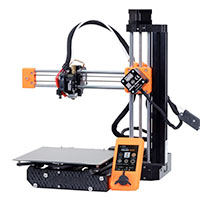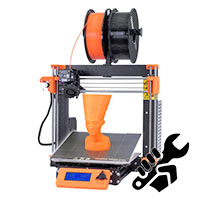
| Product | Description | Price | |
|---|---|---|---|
| Low Budget | |||
 | Monoprice MP Cadet 3D Printer | A beginner's printer. Start printing in under 30 seconds: The printer comes fully assembled and set up is quick and easy using the step-by-step online installation guide. A QR code for the MP Cadet's manual is on the printer itself so you'll never lose the manual. | ∼$160 |
 | Voxelab Aquila | The easy-to-setup kit comes partially assembled, enabling you to learn about the basic construction of 3D printers as you finish putting it together. Equipped with carbon crystal silicon glass plate and super quiet printing designing, the printing model will not easily become warped and the printing sounds is below 50 decibels. | ∼$170 |
 | Creality Ender 3 | An extraordinary and highly popular 3D printer in this price class with a build volume of 22 x 22 x 25 cm (8.66 x 8.66 x 9.84 "). Easy and quick assembly (~2 hours). Only needs 5 minutes for hot bed to reach 110 °C. Ender 3 has a resume printing function after power outage or any other unexpected stoppage. . Upgraded extruder greatly reduces plugging risk and bad extrusion. V-shape with upgrade wheels make it move noiseless, smoothly and durable. | ∼$190 |
| Mid-range budget | |||
 | Prusa MINI+ Semi-assembled | A smart and compact 3D printing workhorse with all the bells and whistles you'd expect from a market leader. It has a print volume of 18 cm (7”) cubed, removable spring steel sheets, ethernet and optional WiFi and it's based on Prusa's brand new custom-made 32-bit Buddy mainboard with silent 2209 Trinamic drivers. | ∼$555 |
 | Creality Ender 3 S1 | One of the best 3D printers under $500. Besides a dual motor-driven Z-axis, it features auto-bed leveling, a removable spring-steel print bed, and, perhaps most notable of all, a custom, compact direct extruder. 96% of the printer body is pre-installed, making assembling convenient with only 6 steps and the maintenance of the printer is simple and easy. Ender-3 S1 features the function of detecting filament runout or breakage/power loss and resume printing after recovery. By accurately recording the printing data at the time of power outage/filament runout or breakage, it helps to avoid the waste of filaments and time caused by accidents. | ∼$430 |
 | Anycubic Vyper | A great, beginner-friendly, first printer for someone serious about their 3D printing hobby. With auto-leveling feature and minimal assembly. Large build volume of 9.6"(L) x 9.6"(W) x 10.2"(H) / 24.5 x 24.5 x 26cm. A handy feature is the Intelligent Resume Printing Function that supports automatically resuming printing after power-off or filament end or breakage. Printing Technology: Fused Deposition Modeling (FDM). | ∼$430 |
| High-end budget | |||
 | Prusa i3 MK3S+ kit | This model offers the reliability and quality of a Prusa printer plus the largest print volume available. Updated with the new SuperPINDA probe for improved first layer calibration, added high-quality Misumi bearings and various useful design tweaks to make the printer easier to assemble and maintain. The MK3S+ includes all the proven features of the previous models, including the heatbed with removable PEI spring steel print sheets, automatic Mesh Bed Leveling, filament sensor, power loss recovery (power panic) and safety features. And it is still as silent as ever. | ∼$1000 |
 | Dremel DigiLab 3D45-EDU | This feature packed, high-quality 3D printer brings the power of advanced FDM 3D printing to your desktop. High quality 3D builds a resolution up to 50 microns which is printed on a heated bed to avoid warping. Built-in RFID detects the filament type (PLA, Nylon, Eco-ABS, PETG) inserted and automatically changes printer settings accordingly. Wifi and USB connectivity, built-in HD camera and included Dremel DigiLab 3D slicing software to manage your prints remotely. With this EDU version, educators can access 20 unique Lesson Plans for Dremel DigiLab 3D printers, based on educational projects, aligned to educational standards (Common Core, NGSS, TEKS) and real-life tested by curriculum experts. | ∼$2200 |
 | QIDI i-Fast | Equipped with a heated chamber, which can be heated to 60 °C, it can print stronger manufacturing grade parts and industrial fixtures. Its dual Z-axis structure with all linear industrial guide rails achieves a printing speed double that of consumer DIY 3D printers. Qidi i-Fast can print almost all kinds of filaments suitable for FDM 3D printers on the market, such as PLA ,PLA+ ,ABS ,PETG, NYLON. In addition, metal filaments can be used to print metal parts, such as bafs 316 stainless steel filaments (sintering treatment is required in the post processing). FDM Technology; Normal dual extruder; High Temp dual extruder. Large printing size of 360x250x320mm | ∼$2500 |
| Professional | |||
 | Ultimaker S5 | The large build volume (33 x 24 x 30cm) S5 is designed for commercial/industrial prototyping. It offers robust dual-extrusion 3D printing with a growing library (200+) of engineering-grade materials including a Metal Expansion Kit that enables users to efficiently switch between printing plastics and metals on one machine and the capability for multi material prints. Included free software Ultimaker Cura (print preparation software) and Ultimaker Digital Factory (printer management software). | ∼$6950 |
 | Raise3D Pro3 Plus | The Raise3D Pro3 Plus is a professional dual extruder 3D printer with user-friendly features and a large build volume (30 x 30 x 60.5 cm / 11.8" × 11.8" × 23.8"), making it an excellent option for production and multi-sized rapid prototyping. The max. print nozzle temperature of 300 °C, allows a wide range of engineering-grade materials from Nylon to metal-filled filament. Includes enhanced features and an artificial intelligence assistant system known as EVE. The Pro3 Series dual extruder 3D printers connect with Raise3D’s 3D printing software ecosystem, that includes a 3D slicing program, ideaMaker, an open-software template called ideaMaker Library, and our cloud-based 3D printing software RaiseCloud. | ∼$7600 |
| Specialty 3-in-1 printer: 3D printing, laser engraving, CNC carving | |||
 | Snapmaker A350T | Dedicated 3D printing, CNC (computer numerical control) milling and engraving, and laser cutting and engraving tool heads give the Snapmaker a huge range of material compatibility to unlock your full creative potential. Although the 3D printing capability lags behind a dedicated printer of the same price range, it can mill wood and laser engrave other materials, too – just with a quick change of the tool head. A large build volume of 320x350x330mm. Custom 3-in-1 software: The free and open-source Snapmaker Luban CAM software with 5-inch touchscreen and intuitive user interface supports Power Loss Recovery, multi-object processing, customized profiles, various built-in cases and multiple languages. | ∼$1800 |
Applications for 3D printing
Types and accuracy of 3D printing technologies
Check out these latest Nanowerk 3D Printing News:
3D-Printed microstructure forest facilitates solar steam generator desalination
 Researchers create bioinspired 3D-printed solar steam generators for desalination, which can also be adapted for solar energy conversion or water purification.
Researchers create bioinspired 3D-printed solar steam generators for desalination, which can also be adapted for solar energy conversion or water purification.
3D Printing of light-activated hydrogel actuators
 Researchers have embedded gold nanorods in hydrogels for 3D printing structures that contract with light exposure and expand when light is removed, enabling remote actuation.
Researchers have embedded gold nanorods in hydrogels for 3D printing structures that contract with light exposure and expand when light is removed, enabling remote actuation.
Precise and less expensive 3D printing of complex, high-resolution structures
 Researchers use two lasers for two-photon polymerization, increasing practicality of this 3D printing approach for consumer electronics, biomedical applications and more.
Researchers use two lasers for two-photon polymerization, increasing practicality of this 3D printing approach for consumer electronics, biomedical applications and more.
Innovative 3D printing method streamlines multi-materials manufacturing
 Researchers have developed a way to create complex devices with multiple materials - including plastics, metals and semiconductors - all with a single machine. The research outlines a novel 3D printing and laser process to manufacture multi-material, multi-layered sensors, circuit boards and even textiles with electronic components.
Researchers have developed a way to create complex devices with multiple materials - including plastics, metals and semiconductors - all with a single machine. The research outlines a novel 3D printing and laser process to manufacture multi-material, multi-layered sensors, circuit boards and even textiles with electronic components.
Researchers demonstrate the first chip-based 3D printer
 Smaller than a coin, this optical device could enable rapid prototyping on the go.
Smaller than a coin, this optical device could enable rapid prototyping on the go.